How to make hard cider with either milk or water kefir grains. This is a very low alcohol drink filled with probiotic goodness.
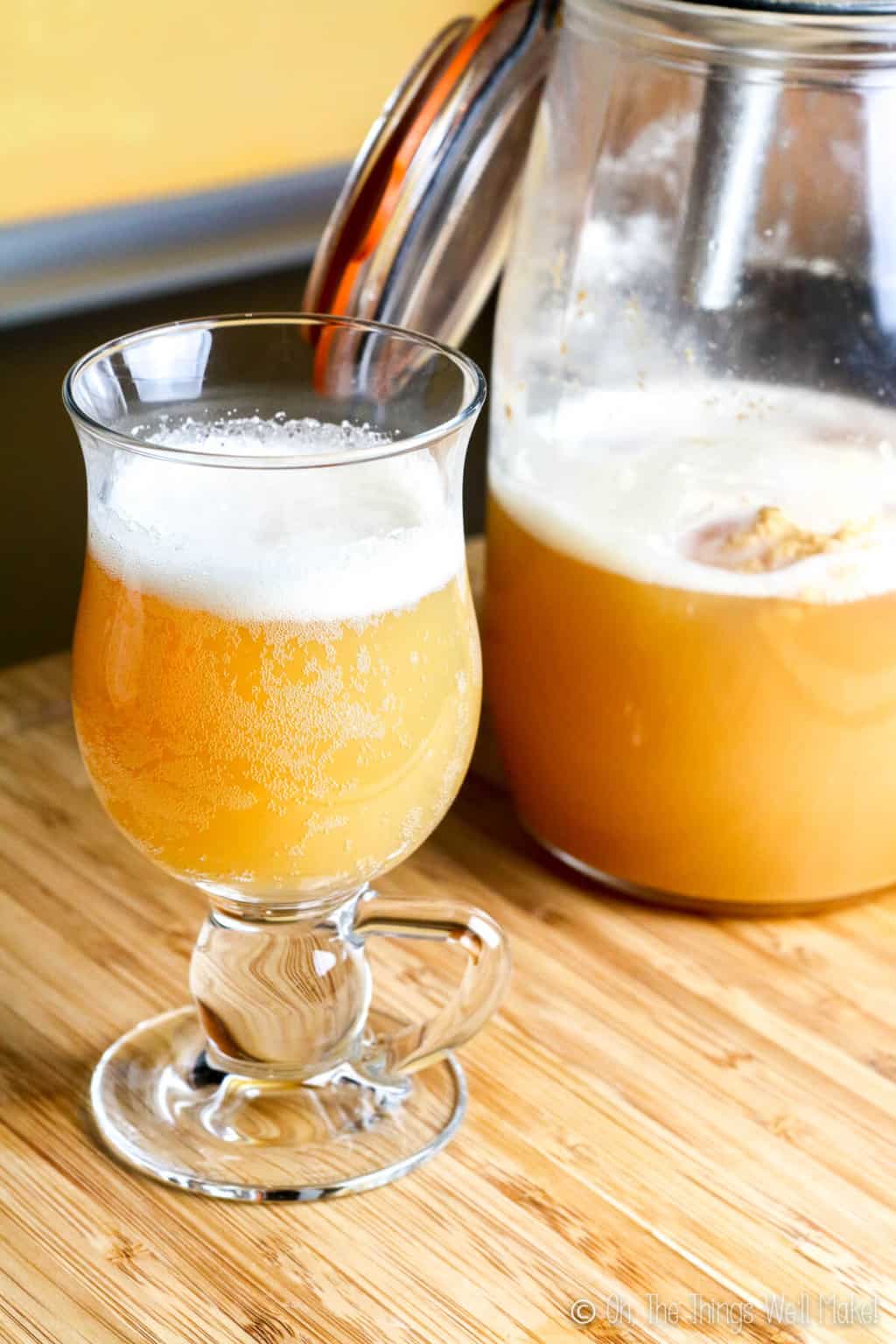
As I hinted in an earlier post, milk kefir grains can be used for more than just making regular milk kefir.
Another tasty, probiotic drink that can be made is a type of kefir “hard” cider. If you don’t like alcohol, though, you still might like it because the amount of alcohol that is formed is very low. Many estimate it to be around 1-1.5%.
I like it because I find unfermented apple juice to be a bit too sweet for my taste.
Making this cider is very easy. What’s great about it is that you don’t have to use water kefir grains. Milk kefir grains can also be used with fruit juices.
Why is that so great?
Well, I got sick of trying to keep so many living organisms alive. For awhile I had kombucha, milk kefir, water kefir, and sourdough starter all going at the same time. Then, of course, I also had to worry about my plants, hens, dogs, and the rest of my family. 🙂
Being able to use milk kefir grains with fruit juice combinations meant that I no longer had to worry about keeping water kefir grains alive. To be honest, I didn’t drink water kefir very often, so it was more of a hassle to care for them than what it was worth for me.
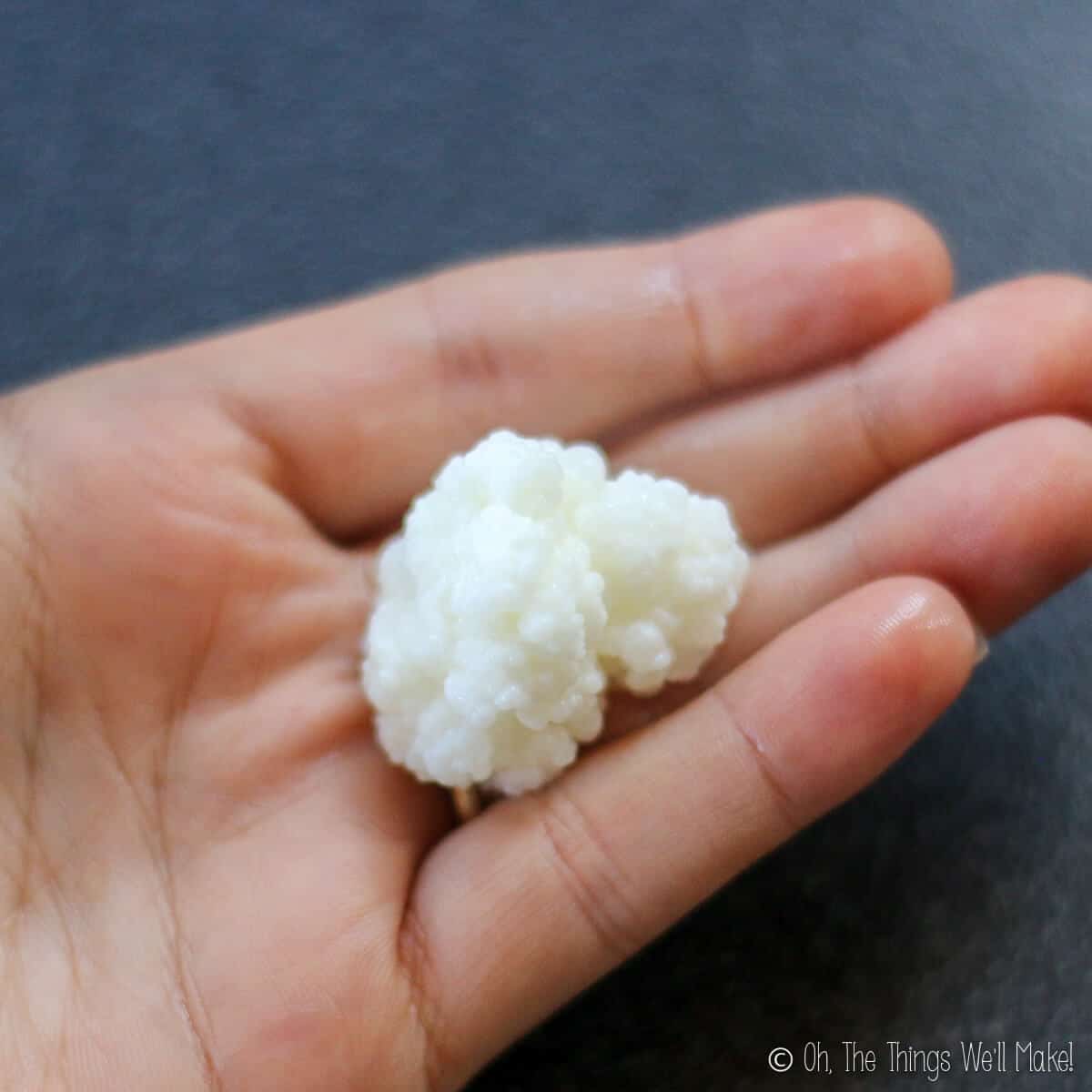
The kefir grains (either milk or water kefir varieties) can be damaged, and may not continue to reproduce, or at least not as quickly, in juice as they do in milk or in sugar water. The acidity of the juice, as well as prolonged fermentation periods, can be harmful to them. Keeping that in mind, you should use some excess grains for these types of experiments, just in case they die off. (Don’t use all of your grains!) Milk kefir grains reproduce quite quickly in milk, so you should have plenty to experiment with soon after starting out with them.
The grains will also start to take on the color of whatever juice you are using. In this case, being apple juice, you can see that the grains are turning brown.
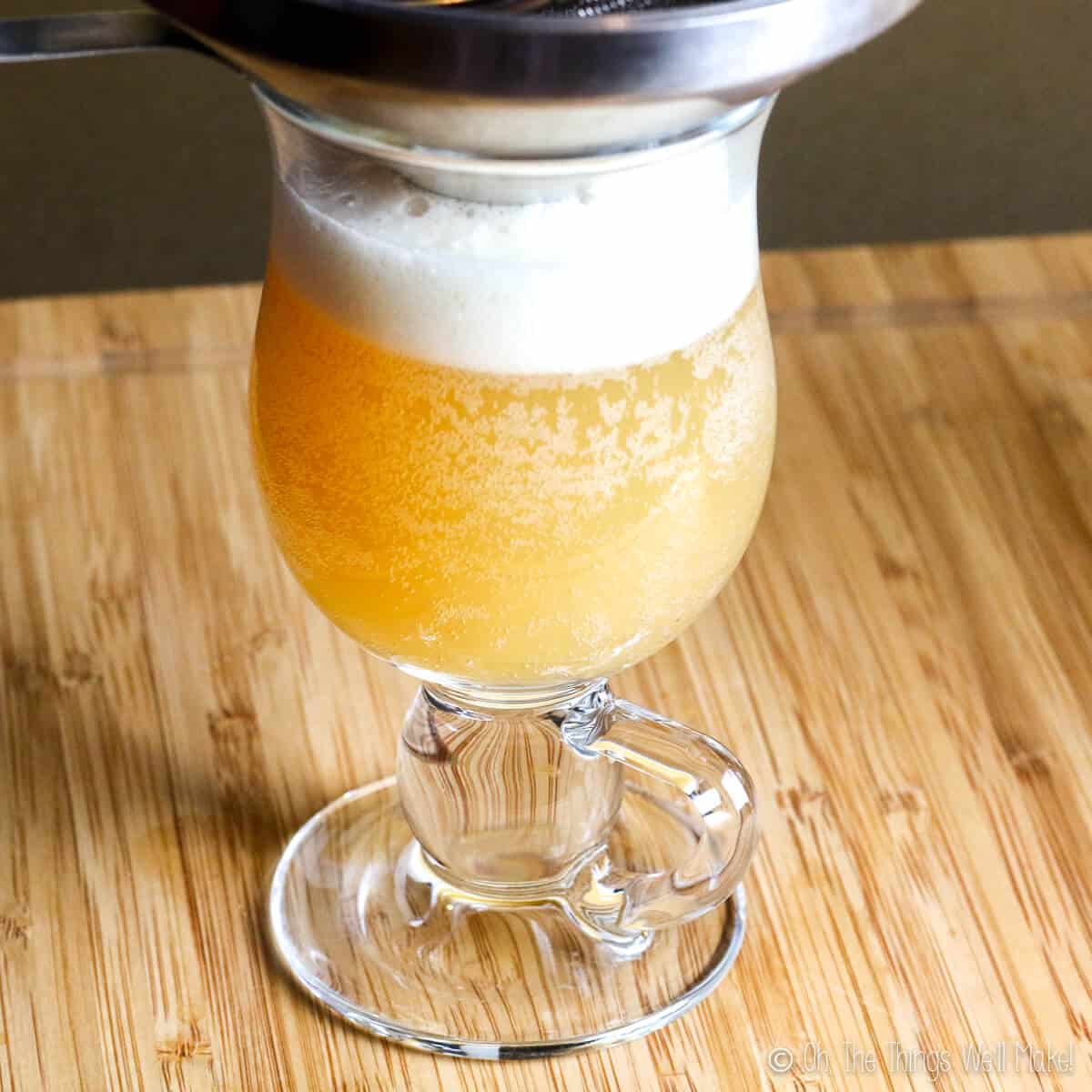
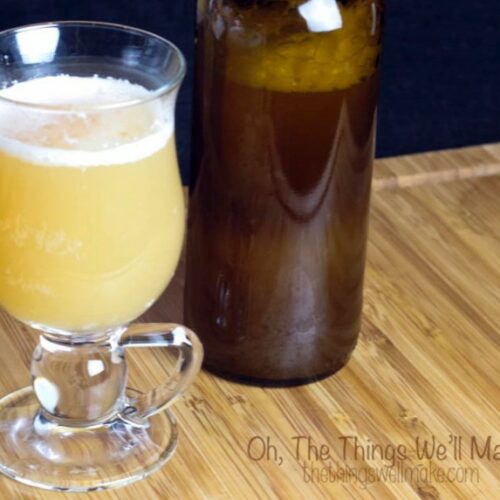
Ingredients
- 1 large milk kefir grain (or about 1 Tbsp. water or milk kefir grains)
- 2-3 cups apple juice
Instructions
- Add your kefir grains to your apple juice in a glass container.
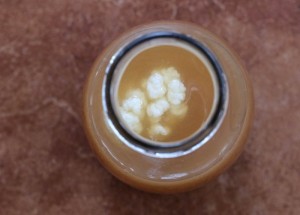
- Let it sit for a day or two (or three). It’s a good idea to taste it every day or so to see how it is developing. Your cider will get less and less sweet as the sugar is being consumed by the kefir grains. The time it takes will depend upon the temperature of your house, the amount of juice used, and the amount of kefir grains being used.
- As it ferments, you will notice that bubbles start to form, so it’s a good idea, if you are letting it sit in an airtight container, to leave a little space at the top, and to check on it and let some air out each day. If you wait too long, the cider will start to taste too yeast-y and gets an unpleasant taste. That’s why it’s a good idea to try it each day and stop when you get to a point that you like.
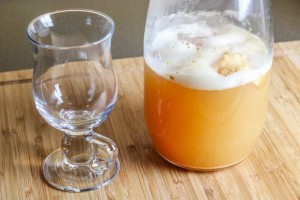
- When it has fermented to your liking, take the grains out, bottle up the cider, and put it in the fridge. The carbonation will continue to build up a bit more with time.
- Now, all that’s left to do is to drink it and its probiotic goodness. Enjoy!
Note: If you don’t have any larger sized milk kefir grains, you can use between ½-1 tsp. smaller grains.
Cheers! Salud! (To your health!)
Looking for other recipes that you can make with your milk kefir grains?
- How to Make Kefir Milk
- Kefir Sour Cream
- Kefir Ice Cream (aka. Frozen Kefir)
 Español
Español
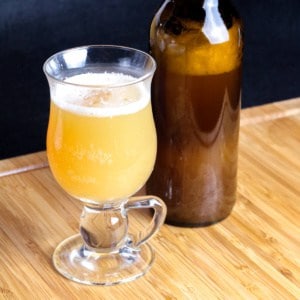
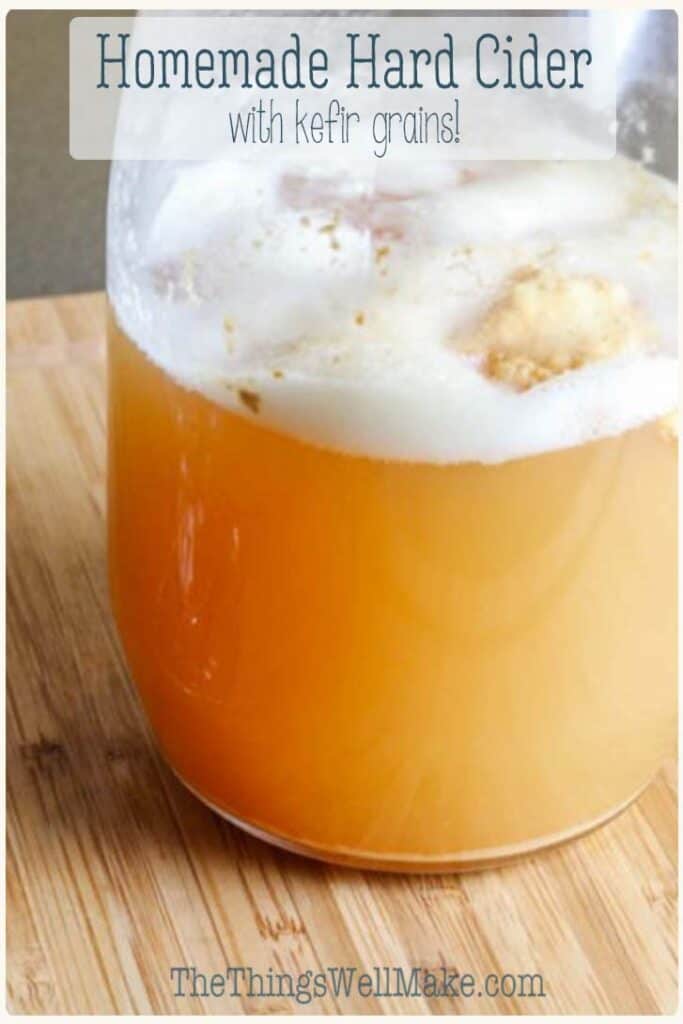
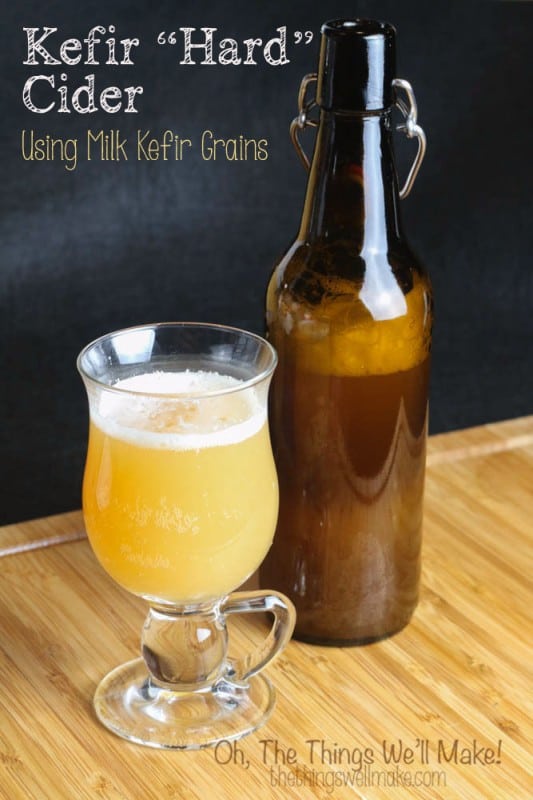
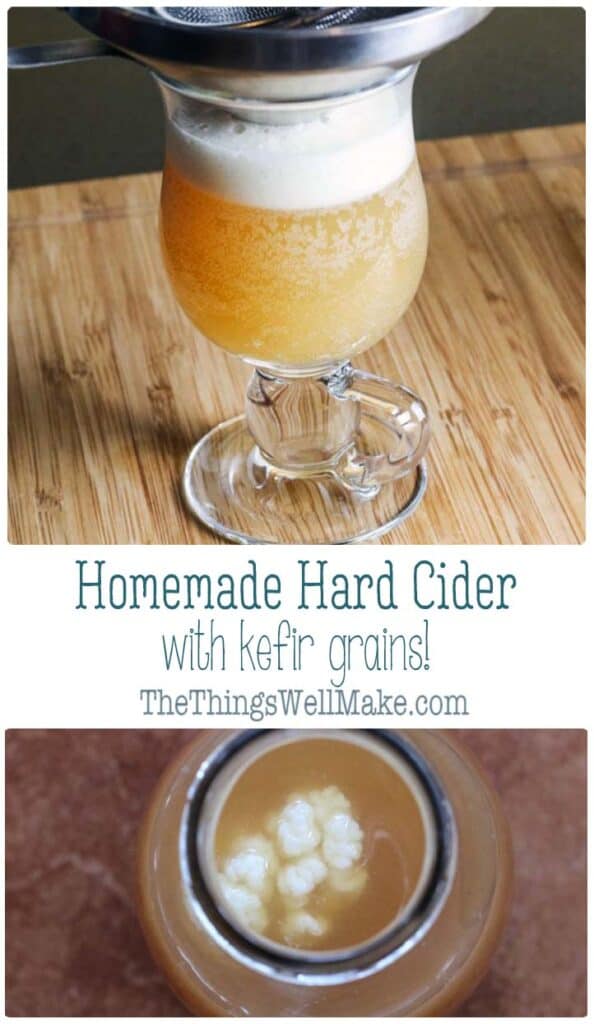
 Slow Cooker Pork Carnitas with Homemade Corn Tortillas (& Paleo Version)
Slow Cooker Pork Carnitas with Homemade Corn Tortillas (& Paleo Version)
Kelly
Great sharing! Want to try the recipe soon.
Nancy
I love this idea! For step 2 are you just covering your cider with cloth or are you capping it? Thanks!
Tracy Ariza, DDS
To develop carbonation, cap it, but check on it and burp it as needed. 😉
Sabina
This may be a silly question, but does raising the alcohol content sabotage the benefits or amount of probiotics that are present? Very curious as I am very new to this fermentation process. Thank you in advance.
Tracy Ariza, DDS
Hi Sabina,
That’s an interesting question. To be honest, I’m not really sure. First, I’d like to point out that the alcohol content of this is very low. Even ferments like kombucha and kefir have a small amount of alcohol. This tastes like it has more alcohol, but I’ve never really tried to calculate what the percentage of alcohol really is.
If you think about the process of making apple cider vinegar, the ferment goes through an alcohol forming stage, and then eventually turns into vinegar. It has health benefits of its own, but not necessarily probiotic ones.
I’d think that this is similar.
Kel Liew
I just made hard cider with it! Can I try further ferment to Kefir apple cider vinegar? Thank you 😉
Tracy Ariza
Hi Kel,
Yes, of course.
I’d love to hear how it turns out.
You may need to add some apples or some sugar to get the fermenting going enough to get there, but maybe not. I’ve made apple cider vinegar from apples, but not from this, so I’m not sure.
Moonyeen Tuyac
Hello,
I fermented my water kefir for almost 3 months,it tastes like vinegar and the color become light and clear. I can feel it has an alcohol content too.
1. Is it safe to drink it? Since it tastes good if I flavored it.
2. Is it safe to use it as a vinegar?
3. Is there an expiration for fermented water kefir?
I keep more than 20 bottles for this experiment. I wish to attain to make it a healthy wine or vinegar. I am just worried about if it safe and its expiration. I wish you could help me.
Thank you.
Moonyeen Tuyac
Tracy Ariza
Hi Moonyeen,
I can’t promise you that it’s safe to drink, but I will say this. It’s very, very likely that it’s fine to consume, especially if it only smells acidic and not otherwise bad…And if you don’t see any sort of dark-colored mold.
I will also say that I’m constantly trying all sorts of fermented things that I’ve had fermenting for months and months and I’m still around and happy and healthy. 😉
Normally vinegar won’t go “bad.” Its quality may change for better or worse, but it won’t normally expire into something bad for you.
So, I guess it’s all about having common sense and looking out for anything unusual looking like scary molds or bad odor.
Michelle
I keep my water kefir sitting for a month and they work better than ever now. The liquid was very sour so I discarded it and have been making very fizzy sodas.
Tracy Ariza, DDS
Interesting!
I just started with water kefir again. I should write a post about it.
Rob
Nice idea, so to keep the kefir alive do I rinse id with water afterwards and then put back in milk?
I have a supply of “flat” cider from a cider company, do you think it would work in that?
Thanks!
Tracy Ariza
Hi Rob,
Yes, I was normally able to rinse the grains in water and recuperate them in milk. That said, I’d probably work with excess grains just in case they were to die off in the juice.
As for the “flat” cider- I guess I’m not really sure what that means. Cider in the US can be a non-filtered apple juice which would work really well for this sort of thing. If it’s a cider that already has an alcohol content, though, it probably wouldn’t have enough sugar to feed the grains well enough to add some gas to it.
In any case, that’s just a guess on my part, and something that would be fun to experiment with!
dave
The alcohol content of kefir tends to be self limiting as the SCOBY is symbiotic – the yeast makes the alcohol and some of the bacteria eat it. Not sure what happens if you add brewers yeast and change the balance, but just adding more sugar as in traditional brewing wont do it.
Eric
Typically this occurs in an oxygenated environment, as Acetobacteraceae (acetic acid bacterias) are what usually consume the ethanol. So limiting oxygen via an airlock or lid will bring your ABV higher. That said, you’re right in that it’s quite difficult to get to the high teens with a scoby like this, and if you did it would likely taste quite rank anyhow.
Tracy Ariza
Hi Eric,
Thanks for your explanation!
I agree that after a certain point, this wouldn’t taste very good. 🙂
Juanita
I over fermented water keifer and it was too sour, so after I strained it I added some sugar and put it in the refrigerator. Several hours later it seemed to have a fairly high alcohol content.
Tracy Ariza
Hi Juanita,
Yes, sometimes I’ll get a combination that tastes like it has a higher alcohol content. I wish I knew how to measure it.
Sometimes my kombucha tastes more like champagne. 🙂
Nick
Hi, i tried this and it came out great. I’m just wondering how i could up the alcohol content? Would adding apple peel to the juice work? More grains? Longer ferment?
best
Nick
Tracy Ariza
Hi Nick,
I’m glad you liked it.
I’m not sure what the apple peel would do to it, but a longer fermentation period should increase the alcohol content. I’m not sure you’d even need to leave the kefir grain(s) in the juice after the first day or two (so as not to kill them), but even just fermenting further at room temperature might be enough.
The longer you ferment it, the less sweet it will be, and the more carbonation you will have. The alcohol level should also increase, but I’m not really sure by how much.
Eventually, though, it may turn into vinegar. I haven’t ever reached that stage, though, to know for sure.
More grains would likely make the fermentation period go more quickly, but then you risk harming a lot of grains if you don’t have that many to work with.
Michael
You could add a bit of dry beer or wine yeast after you take out the kefir grains and let it ferment a bit longer. It will start to get a bit yeasty, but those yeasts are hearty enough to convert all the sugars into alcohol. I would add an airlock to keep it from turning into vinegar though. Experiment 🙂
Tracy Ariza
Hi Michael,
Interesting idea. Thanks for your insight!
I was just about to buy an airlock or two to try a few other fermenting experiments, so maybe I’ll give it a try. 🙂
Malcolm
You can remove the kefir grains after a day or two. They will have inoculated the juice and there will be a thriving yeast community that is now independent of the grains. You’ll start to see the yeast settling on the bottom of the bottle.
If you keep some of this yeast you can pitch it directly into the next batch of juice. Just like kefir, it will keep going, as long as you feed it.
Tracy Ariza
Hi Malcolm,
That’s a great point, and a great idea!
It would keep the kefir grains safe, and allow for further ferments. I’ll have to update the post with your idea! I love it when readers can help each other (and me) out with new, better ways of doing things.
Thanks so much!